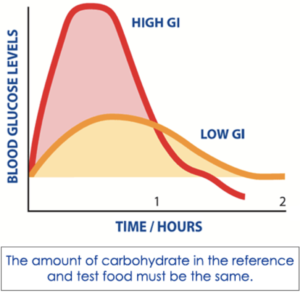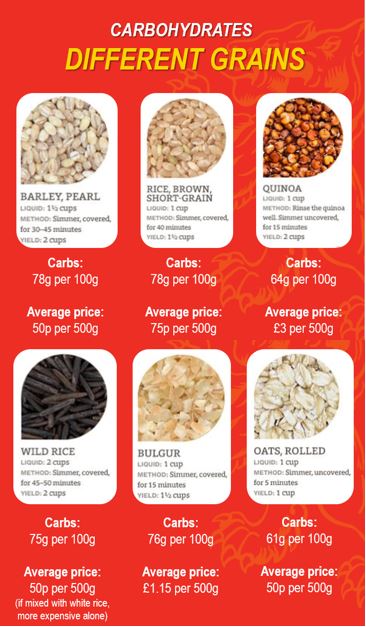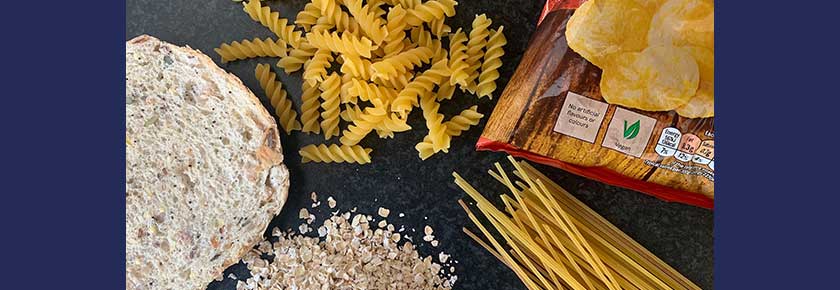Contrary to popular belief, carbohydrates are not the enemy! When you’re being active, it’s important to consume carbohydrates as part of your diet to provide energy for training and to aid recovery. In this article UoB Sport and Fitness Nutrition Intern, Sam, talks to us about some of the different types of carbohydrates and provides guidance on carbohydrate consumption surrounding training. As a result of the government’s new guidelines surrounding Coronavirus you may find yourself exercising less. However, carbohydrates remain an integral part of your diet, and the following information will help you to tailor your carbohydrate intake to your current exercise levels.
What is glycaemic index?
Glycaemic index (GI) refers to the speed at which carbohydrates are digested and absorbed into the body. Carbohydrates are ranked on a GI scale of 0-100, dependent on the rate at which they raise blood glucose (sugar) levels.
- Glycaemic index of 55 or less = low GI
 Glycaemic index of 56-69 = mid-range GI
Glycaemic index of 56-69 = mid-range GI- Glycaemic index of 70 or more = high GI
DID YOU KNOW?
The riper a fruit or vegetable is, the higher its glycaemic index!
White (simple) carbohydrates like white bread or pasta tend to have a higher GI, causing a rapid spike in energy levels. Wholegrain (complex) carbohydrates tend to have a lower GI, meaning glucose is absorbed into the blood stream at a slower rate. It is advised to consume wholegrain carbohydrates the majority of the time, as these provide ‘longer lasting energy’ and contain more fibre and nutrients.
EXAMPLES OF LOW GI BREAKFASTS
- Porridge, Bran flakes, Muesli, Wholegrain toast
EXAMPLES OF HIGH GI BREAKFASTS
- Cornflakes, Coco pops, Cheerios, White toast
Carbohydrate fuelling before exercise
The amount of carbohydrates you should consume before exercise is dependent on the timing of carbohydrate fuelling. If you’re eating more than 2 hours before exercising, it is recommended that you consume around 100g of low GI carbohydrates. Examples of these include porridge, wholegrain pasta, and bran cereals. If you’re eating less than 1 hour before exercising, it is recommended that you consume around 50g of high GI carbohydrates. White rice, white pasta, and sports drinks are examples of high GI carbs. If you currently consume very low levels of carbohydrates before exercising it is important that you gradually work up to higher levels to limit any stomach discomfort as a result of a sudden dietary change.
It is worth noting that these values (and the recommendations throughout this article) simply provide a guide to carbohydrate fuelling, and the exact amount you require will be largely dependent on you as an individual and your sport.
Carbohydrate fuelling during exercise 
During exercise lasting 1 hour or less, for example going on a run, consume up to 20g of easily digestible carbohydrates (e.g. glucose – the main source of energy for humans). Carbohydrate mouth rinsing involves swilling a high carbohydrate solution around your mouth for 5-10 seconds and then spitting it out (similar to how you would use mouthwash). This appears to improve performance in short duration, high-intensity exercise. This may be a result of the brain linking oral carbohydrate sensing to motor output. Mouth rinsing tricks the brain into thinking carbohydrates are being consumed, causing the brain to send motor signals which activate more muscles. The effects of mouth rinsing are more pronounced when athletes perform while fasted.
When exercising for longer durations, it is crucial you take on carbohydrates to maintain energy levels. During exercise lasting 1-2 hours, consume 30-60g of easily digestible carbohydrates (e.g. glucose). During exercise lasting over 2 hours, consume 60-90g of easily digestible carbohydrates from multiple sources (e.g. glucose and fructose). Glucose and fructose enter the blood stream in different ways, meaning blood glucose levels increase at a greater rate (fructose is converted to glucose in the liver). Check out some of the carbohydrate content in a few foods below:
| Source | Grams of Carbohydrate |
|---|---|
| 1 Cliff energy bar | 42g carbs |
| 1 energy gel sachet | ~20-30g carbs |
| 1 Lucozade sport | 32g carbs |
| 1 bananas | 30g carbs |
| 4 slices malt loaf | 50g carbs |
| 1 pint chocolate milk | 50g carbs |
| 100g oats | 66g carbs |
| 10 dates | 50g carbs |
| 75g pasta | 56g carbs |
| 75g rice | 60g carbs |
Carbohydrate fuelling post-exercise
Following exercise, ensure you consume a snack/drink containing carbohydrates ASAP to begin the recovery process immediately. You should also eat a larger snack or meal 1-2 hours post-exercise containing carbohydrates. The higher the intensity or longer the duration of an exercise session, the more carbohydrates you will require for recovery. It is important to recover properly after exercise, in order to replenish the body’s glycogen (energy) stores and reduce the likelihood of fatigue in following training sessions. Fatigue can lead to underperformance and injury! If you need to recover quickly after training (e.g. if you have another training session that day), consume carbs with a high glycaemic index at regular intervals post-exercise. Remember that it is also important to have 20-30g of protein post-exercise to aid the growth and repair of muscle.
How can I incorporate a variety of carbohydrates into my diet?

01.04.20





